信息化教学设计英语
- 格式:doc
- 大小:64.00 KB
- 文档页数:4
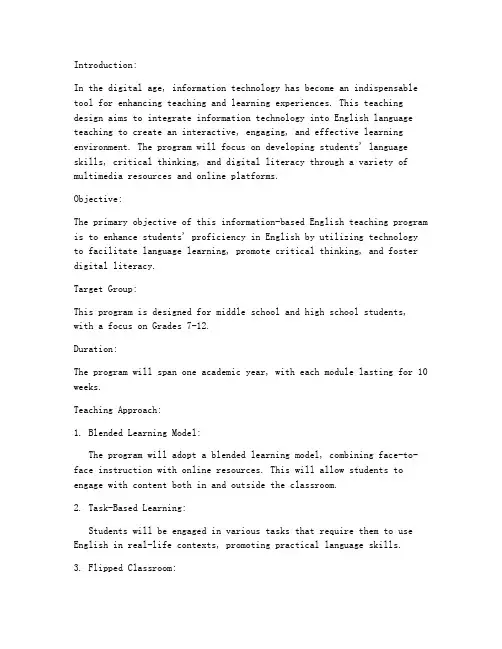
Introduction:In the digital age, information technology has become an indispensable tool for enhancing teaching and learning experiences. This teaching design aims to integrate information technology into English language teaching to create an interactive, engaging, and effective learning environment. The program will focus on developing students' language skills, critical thinking, and digital literacy through a variety of multimedia resources and online platforms.Objective:The primary objective of this information-based English teaching program is to enhance students' proficiency in English by utilizing technology to facilitate language learning, promote critical thinking, and foster digital literacy.Target Group:This program is designed for middle school and high school students, with a focus on Grades 7-12.Duration:The program will span one academic year, with each module lasting for 10 weeks.Teaching Approach:1. Blended Learning Model:The program will adopt a blended learning model, combining face-to-face instruction with online resources. This will allow students to engage with content both in and outside the classroom.2. Task-Based Learning:Students will be engaged in various tasks that require them to use English in real-life contexts, promoting practical language skills.3. Flipped Classroom:Students will be expected to watch video lectures or read online materials at home, allowing class time to be dedicated to discussion, practice, and application.Module Structure:The program will be divided into four main modules, each focusing on a different aspect of language learning:1. Basic Language Skills:- Grammar and vocabulary development through interactive online platforms and mobile applications.- Listening and speaking activities using audio and video resources.2. Reading and Writing:- Online reading materials, including e-books and digital newspapers, to develop comprehension skills.- Writing exercises using blogging platforms and collaborativewriting tools.3. Critical Thinking and Digital Literacy:- Analysis of online content to promote critical thinking skills.- Introduction to digital tools and resources for research andproject work.4. Project-Based Learning:- Group projects requiring students to research, plan, and present on a chosen topic using English.- Use of multimedia tools, such as video production and presentation software, to showcase their work.Teaching Materials and Resources:1. Online Platforms:- Interactive language learning websites like Duolingo, BBC Learning English, and Coursera.- Online libraries and databases for reading materials.2. Mobile Applications:- Language learning apps such as Rosetta Stone, Memrise, and HelloTalk for vocabulary and grammar practice.3. Digital Tools:- Google Classroom for managing assignments and communication.- Microsoft Office 365 for document creation and collaboration.4. Printed Materials:- Traditional textbooks and workbooks as supplementary resources.Assessment:1. Formative Assessment:- Regular quizzes and tests to monitor progress.- Online forums and discussions to assess engagement and participation.2. Summative Assessment:- End-of-module projects and presentations.- Final exams based on the curriculum objectives.Conclusion:This information-based English teaching program aims to leverage the power of technology to create a dynamic and effective learning environment. By integrating various digital tools and resources, the program seeks to enhance students' language skills, critical thinking abilities, and digital literacy, preparing them for the challenges of the 21st century.。
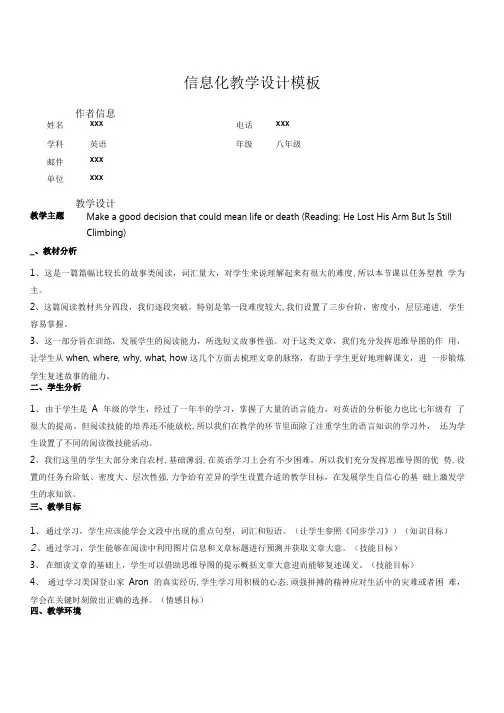
信息化教学设计模板作者信息姓名XXX电话XXX学科英语年级八年级邮件XXX单位XXX教学设计教学主题Make a good decision that could mean life or death (Reading: He Lost His Arm But Is Still Climbing)_、教材分析1、这是一篇篇幅比较长的故事类阅读,词汇量大,对学生来说理解起来有很大的难度,所以本节课以任务型教学为主。
2、这篇阅读教材共分四段,我们逐段突破,特别是第一段难度较大,我们设置了三步台阶,密度小,层层递进, 学生容易掌握。
3、这一部分旨在训练,发展学生的阅读能力,所选短文故事性强。
对于这类文章,我们充分发挥思维导图的作用,让学生从when, where, why, what, how这几个方面去梳理文章的脉络,有助于学生更好地理解课文,进一步锻炼学生复述故事的能力。
二、学生分析1、由于学生是A年级的学生,经过了一年半的学习,掌握了大量的语言能力,对英语的分析能力也比七年级有了很大的提高。
但阅读技能的培养还不能放松,所以我们在教学的环节里面除了注重学生的语言知识的学习外,还为学生设置了不同的阅读微技能活动。
2、我们这里的学生大部分来自农村,基础薄弱,在英语学习上会有不少困难,所以我们充分发挥思维导图的优势,设置的任务台阶低、密度大、层次性强,力争给有差异的学生设置合适的教学目标,在发展学生自信心的基础上激发学生的求知欲。
三、教学目标1、通过学习,学生应该能学会文段中出现的重点句型,词汇和短语。
(让学生参照《同步学习》)(知识目标)2、通过学习,学生能够在阅读中利用图片信息和文章标题进行预测并获取文章大意。
(技能目标)3、在细读文章的基础上,学生可以借助思维导图的提示概括文章大意进而能够复述课文。
(技能目标)4、通过学习美国登山家Aron的真实经历,学生学习用积极的心态,顽强拼搏的精神应对生活中的灾难或者困难,学会在关键时刻做出正确的选择。
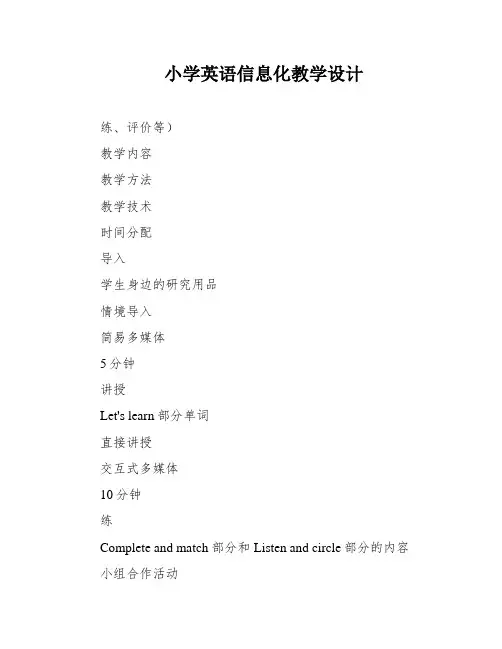
小学英语信息化教学设计
练、评价等)
教学内容
教学方法
教学技术
时间分配
导入
学生身边的研究用品
情境导入
简易多媒体
5分钟
讲授
Let's learn部分单词
直接讲授
交互式多媒体
10分钟
练
Complete and match部分和Listen and circle部分的内容小组合作活动
网络多媒体
15分钟
评价
学生自我介绍研究用品
小组展示
移动研究
10分钟
七、教学评价
1.教学效果评价:通过学生的听、说、读、写四个方面的
表现,来评价教学效果。
2.教学过程评价:通过观察学生在教学过程中的表现,来
评价教学过程。
3.教学方法评价:通过学生的研究反应和教师的教学感受,来评价教学方法。
4.教学环境评价:通过学生的研究反应和教师的教学感受,来评价教学环境。
5.教学资源评价:通过学生的研究反应和教师的教学感受,来评价教学资源。
源、工具)
本文介绍了一种多元化的教学方法,旨在通过训练、实验、研讨、探究、评价和建构等多种方式,提高学生的研究效果。
其中,引导学生通过观察图片并说出英文名称,既锻炼了他们的听、说、读、写能力,又激发了他们的研究兴趣。
在教学特色方面,本文强调了个性化教学和自主研究的重要性,同时也探讨了教与学方式的创新。
通过综合运用图片、视频、课件等信息技术工具,教师可以更好地支持学生的研究。
最终,这种多元化教学方法可以帮助学生更好地掌握知识,提高研究成绩。
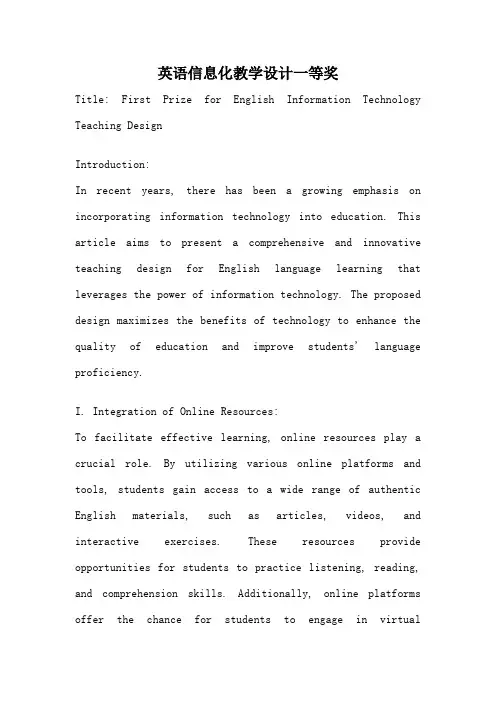
英语信息化教学设计一等奖Title: First Prize for English Information Technology Teaching DesignIntroduction:In recent years, there has been a growing emphasis on incorporating information technology into education. This article aims to present a comprehensive and innovative teaching design for English language learning that leverages the power of information technology. The proposed design maximizes the benefits of technology to enhance the quality of education and improve students' language proficiency.I. Integration of Online Resources:To facilitate effective learning, online resources play a crucial role. By utilizing various online platforms and tools, students gain access to a wide range of authentic English materials, such as articles, videos, and interactive exercises. These resources provide opportunities for students to practice listening, reading, and comprehension skills. Additionally, online platforms offer the chance for students to engage in virtualdiscussions and collaborative projects, fostering a sense of active learning and communication.II. Interactive Language Learning Applications:To enhance students' engagement and motivation, interactive language learning applications can be integrated into the teaching design. These applications offer personalized learning experiences, adaptive assessments, and instant feedback. Gamification elements, such as rewards and leaderboards, can be incorporated to create a competitive and enjoyable learning environment. These applications not only make language learning more enjoyable but also provide opportunities for students to practice speaking and writing skills in a simulated context.III. Virtual Reality (VR) Immersion:With the advancement of technology, virtual reality (VR) has emerged as a powerful tool for language learning. By immersing students in virtual environments, VR enables them to experience real-life situations and practice language skills in a realistic context. For instance, students can virtually travel to English-speaking countries, visit famous landmarks, and interact with virtual characters toimprove their language proficiency. VR technology offers a unique and immersive learning experience that enhances students' understanding and retention of English language concepts.IV. Blended Learning Approach:To cater to diverse learning styles and preferences, a blended learning approach can be adopted. This approach combines traditional classroom teaching with online learning activities. In the classroom, teachers can provide face-to-face instruction, conduct group discussions, and facilitate interactive activities. Online components can be used for self-paced learning, homework assignments, and individual practice. This blended learning approach promotes flexibility, autonomy, and self-directed learning, allowing students to progress at their own pace while receiving personalized guidance from teachers.V. Data Analytics for Individualized Feedback:Information technology also enables the collection and analysis of data to provide individualized feedback. By tracking students' learning progress and performance through online platforms, teachers can gather valuableinsights into each student's strengths and weaknesses. Based on this data, teachers can provide targeted feedback and tailor instructional strategies to meet individual learning needs. This data-driven approach helps optimize teaching effectiveness and ensures that students receive personalized support throughout their language learning journey.Conclusion:The integration of information technology into English language teaching brings numerous benefits to both teachers and students. Through the utilization of online resources, interactive language learning applications, virtual reality immersion, blended learning, and data analytics, students gain access to a more engaging, interactive, and personalized learning experience. By embracing these innovative teaching approaches, English language education can be transformed, leading to improved language proficiency and ultimately, the achievement of the first prize in teaching design.。
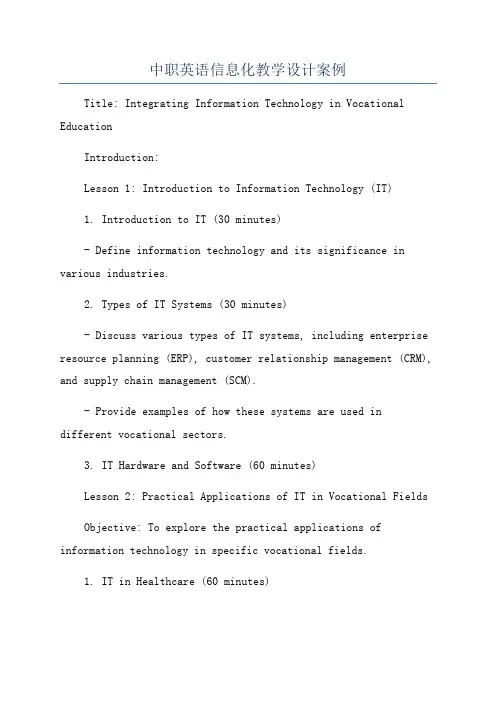
中职英语信息化教学设计案例Title: Integrating Information Technology in Vocational EducationIntroduction:Lesson 1: Introduction to Information Technology (IT)1. Introduction to IT (30 minutes)- Define information technology and its significance in various industries.2. Types of IT Systems (30 minutes)- Discuss various types of IT systems, including enterprise resource planning (ERP), customer relationship management (CRM), and supply chain management (SCM).- Provide examples of how these systems are used indifferent vocational sectors.3. IT Hardware and Software (60 minutes)Lesson 2: Practical Applications of IT in Vocational Fields Objective: To explore the practical applications of information technology in specific vocational fields.1. IT in Healthcare (60 minutes)- Discuss the use of electronic health records, telemedicine, and medical imaging systems.- Organize a virtual tour or guest lecture by professionals working in healthcare IT.2. IT in Manufacturing and Engineering (60 minutes)3. IT in Business and Marketing (60 minutes)Lesson 3: Ethical and Security Considerations in ITObjective: To address ethical and security issues related to information technology.1. Ethical Use of IT (30 minutes)- Discuss the importance of ethical behavior when using IT systems, including privacy, copyright laws, and responsible data usage.- Engage students in a class discussion about real-life ethical dilemmas related to information technology.2. IT Security (60 minutes)- Teach students how to protect themselves and their devices from cyber-attacks.3. IT and Cybersecurity Careers (30 minutes)- Introduce different career opportunities in the field of cybersecurity.- Invite a guest speaker who works in cybersecurity to share their experiences and provide career guidance.Conclusion:。
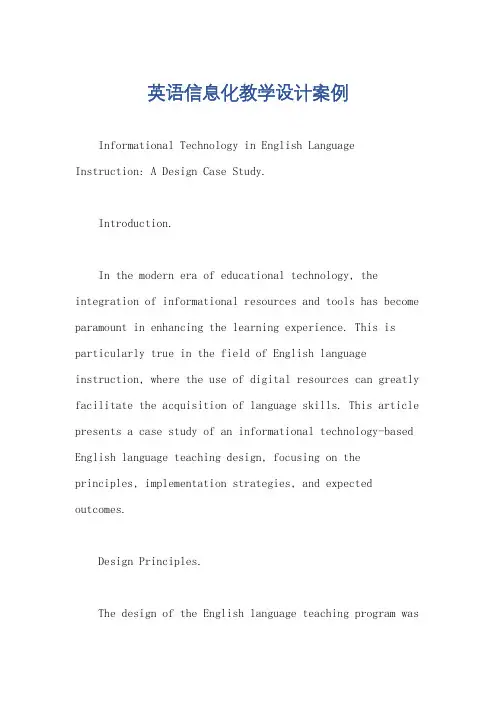
英语信息化教学设计案例Informational Technology in English Language Instruction: A Design Case Study.Introduction.In the modern era of educational technology, the integration of informational resources and tools has become paramount in enhancing the learning experience. This is particularly true in the field of English language instruction, where the use of digital resources can greatly facilitate the acquisition of language skills. This article presents a case study of an informational technology-based English language teaching design, focusing on the principles, implementation strategies, and expected outcomes.Design Principles.The design of the English language teaching program wasguided by several key principles:1. Student-Centered Learning: The program places the student at the center of the learning process, encouraging active participation and collaboration. Digital resources are used to create an interactive and engaging learning environment that caters to the diverse needs and interests of students.2. Blended Learning: The program combines traditional classroom instruction with online learning activities, leveraging the strengths of both approaches. This allows for a flexible and personalized learning experience that accommodates different learning styles and schedules.3. Authentic Language Use: The program emphasizes the use of authentic language materials and real-world scenarios to promote meaningful language use. This helps students develop the ability to communicate effectively in real-life contexts.4. Technology Integration: The program integrates arange of educational technologies, including interactive whiteboards, online learning platforms, and multimedia resources. These tools are used to enhance teaching and learning, making the content more accessible and engaging.Implementation Strategies.The following strategies were employed in the implementation of the English language teaching program:1. Curriculum Development: A comprehensive curriculum was developed that aligns with national education standards and incorporates informational technology resources. The curriculum covers a range of language skills, including reading, writing, speaking, and listening.2. Teacher Training: Teachers were provided with professional development opportunities to equip them with the necessary skills and knowledge to effectively integrate informational technology into their teaching practices. This included workshops on digital tools and resources, as well as strategies for promoting student engagement andcollaboration.3. Classroom Practices: In the classroom, teachers utilized digital resources to create interactive and engaging learning experiences. They employed a variety of teaching methods, such as collaborative projects, role-playing activities, and online discussions, to promoteactive learning and language use.4. Online Learning Platform: An online learningplatform was introduced to support blended learning. This platform provided students with access to digital materials, online assignments, and interactive exercises. It also allowed for teacher-student and student-student communication, facilitating collaboration and feedback.Expected Outcomes.The expected outcomes of the English language teaching program include:1. Improved Language Skills: Students will demonstrateimproved reading, writing, speaking, and listening skills through regular practice and exposure to authentic language materials.2. Enhanced Engagement and Motivation: The use of digital resources and interactive learning activities will foster a more engaging and motivating learning environment, increasing student participation and engagement.3. Development of Collaborative Skills: Collaborative projects and online discussions will promote teamwork and communication skills, preparing students for future academic and professional challenges.4. Preparedness for the Digital Age: By integrating informational technology into their learning experiences, students will be better prepared to navigate the digital age and utilize technology effectively in their academic and career pursuits.In conclusion, the integration of informational technology in English language instruction offerssignificant benefits to both teachers and students. By embracing a student-centered, blended learning approachthat leverages the power of digital resources and tools, we can create a more engaging, effective, and future-ready learning environment.。
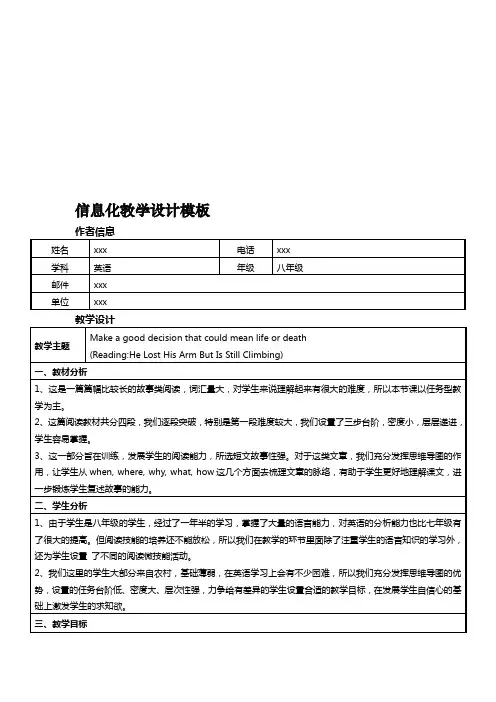
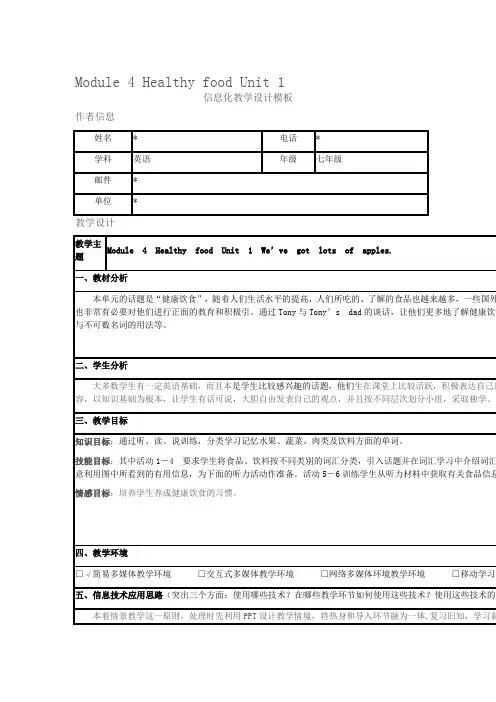
Module 4 Healthy food Unit 1信息化教学设计模板作者信息姓名*电话*学科英语年级七年级邮件*单位*教学设计教学主Module 4 Healthy food Unit 1 We’ve got lots of apples.题一、教材分析本单元的话题是“健康饮食”,随着人们生活水平的提高,人们所吃的、了解的食品也越来越多,一些国外也非常有必要对他们进行正面的教育和积极引。
通过Tony与Tony’s dad的谈话,让他们更多地了解健康饮食与不可数名词的用法等。
二、学生分析大多数学生有一定英语基础,而且本是学生比较感兴趣的话题,他们生在课堂上比较活跃,积极表达自己的容,以知识基础为根本,让学生有话可说,大胆自由发表自己的观点,并且按不同层次划分小组,采取独学、对三、教学目标知识目标:通过听、读、说训练,分类学习记忆水果、蔬菜、肉类及饮料方面的单词。
技能目标:其中活动1-4 要求学生将食品、饮料按不同类别的词汇分类,引入话题并在词汇学习中介绍词汇意利用图中所看到的有用信息,为下面的听力活动作准备。
活动5-6训练学生从听力材料中获取有关食品信息情感目标:培养学生养成健康饮食的习惯。
四、教学环境□√简易多媒体教学环境□交互式多媒体教学环境□网络多媒体环境教学环境□移动学习五、信息技术应用思路(突出三个方面:使用哪些技术?在哪些教学环节如何使用这些技术?使用这些技术的预本着情景教学这一原则,处理时先利用PPT设计教学情境,将热身和导入环节融为一体,复习旧知,学习新生,让学生对所学单词有一个直观认识,易于掌握新知识。
讲授句型时,利用PPT设计语境,让学生新学句型。
六、教学流程设计(可加行)教学环节(如:导入、讲授、复习、教师训练、实验、研讨、探究、评价、建构)Warming-up播放蟑螂乐队的《吃什么才好》激发学生的学习兴趣,同时为下面的学习做铺垫。
Leading-in 出示食物图片,创设情境教授新单词(如果你感到饥饿,想吃点什么呢?由此导入新课)Presentation . 学习单词的同时引导学生回答问句Have you got apples/strawberries … ?. 听力训练4、5、7,教授学生听力技巧.Practice 1.设计游戏 guessing game ,巩固新学单词.设计group work :Interview and give a report 巩固新学句型Have you got apples t got ...教师先做示范。
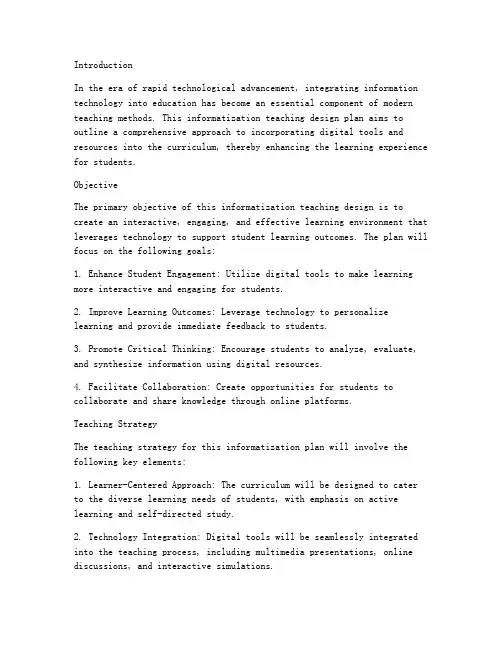
IntroductionIn the era of rapid technological advancement, integrating information technology into education has become an essential component of modern teaching methods. This informatization teaching design plan aims to outline a comprehensive approach to incorporating digital tools and resources into the curriculum, thereby enhancing the learning experience for students.ObjectiveThe primary objective of this informatization teaching design is to create an interactive, engaging, and effective learning environment that leverages technology to support student learning outcomes. The plan will focus on the following goals:1. Enhance Student Engagement: Utilize digital tools to make learning more interactive and engaging for students.2. Improve Learning Outcomes: Leverage technology to personalize learning and provide immediate feedback to students.3. Promote Critical Thinking: Encourage students to analyze, evaluate, and synthesize information using digital resources.4. Facilitate Collaboration: Create opportunities for students to collaborate and share knowledge through online platforms.Teaching StrategyThe teaching strategy for this informatization plan will involve the following key elements:1. Learner-Centered Approach: The curriculum will be designed to cater to the diverse learning needs of students, with emphasis on active learning and self-directed study.2. Technology Integration: Digital tools will be seamlessly integrated into the teaching process, including multimedia presentations, online discussions, and interactive simulations.3. Blended Learning: A combination of face-to-face and online learning will be adopted to provide flexibility and cater to different learning styles.4. Continuous Assessment: Regular formative assessments will be conducted to monitor student progress and provide timely feedback.Curriculum DesignThe curriculum will be structured around the following themes:1. Digital Literacy: Introduce students to basic digital skills, such as keyboarding, word processing, and online research.2. Content Knowledge: Cover subject-specific content using digital resources, including e-books, online lectures, and interactive modules.3. Project-Based Learning: Engage students in real-world projects that require the use of technology to solve problems and demonstrate their knowledge.4. Critical Thinking and Problem-Solving: Develop students' critical thinking and problem-solving skills through activities that encourage analysis and synthesis of information.Technology ResourcesThe following technology resources will be utilized to support the informatization teaching design:1. Interactive Whiteboards: To facilitate group discussions and collaborative learning.2. Laptops/Computers: To provide students with access to digital resources and online learning platforms.3. Educational Software: Such as simulation software, multimedia authoring tools, and learning management systems.4. Online Collaboration Tools: To enable students to work together on projects and share resources.Implementation ScheduleThe implementation of this informatization teaching design will be carried out in the following stages:1. Preparation: Selection of appropriate digital tools and resources, as well as training for teachers on their effective use.2. piloting: A pilot phase to test the effectiveness of the teaching plan and make necessary adjustments.3. Rollout: Full-scale implementation of the plan, with continuous monitoring and evaluation of its impact on student learning outcomes.EvaluationThe success of this informatization teaching design will be evaluated based on the following criteria:1. Student Engagement: Measure student participation and engagement through surveys, class discussions, and attendance records.2. Learning Outcomes: Assess student performance on formative and summative assessments.3. Teacher Feedback: Collect feedback from teachers on the effectiveness of the teaching plan and the integration of technology.4. Student Feedback: Gather feedback from students on their learning experience and the use of technology in the classroom.By adopting this informatization teaching design plan, we aim to create a dynamic and effective learning environment that empowers students to become confident, competent, and lifelong learners in the digital age.。
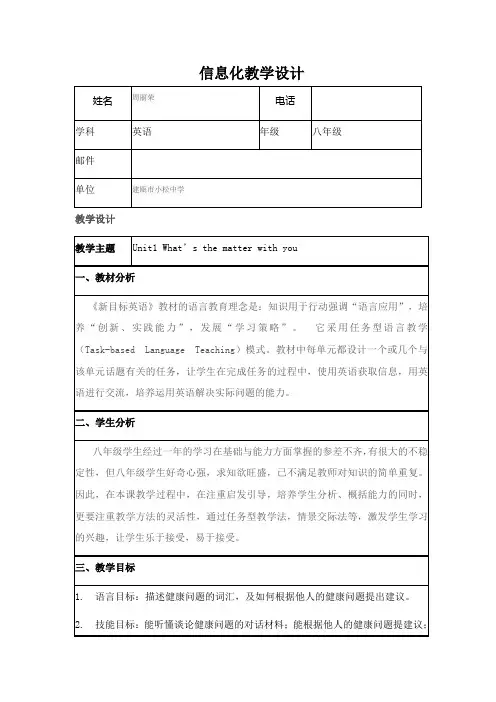
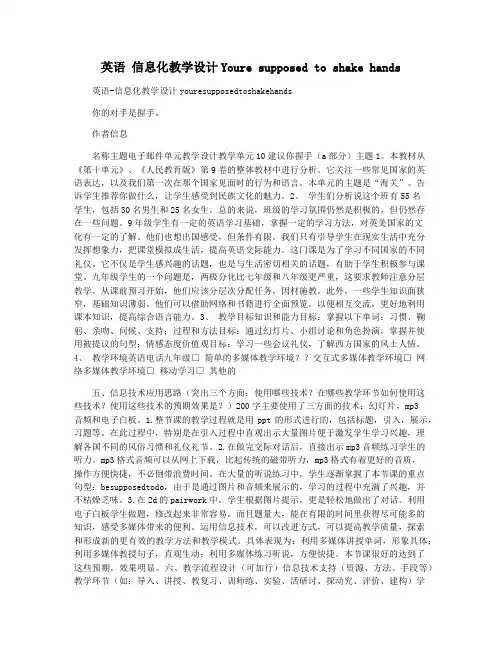
英语信息化教学设计Youre supposed to shake hands英语-信息化教学设计youresupposedtoshakehands你的对手是握手。
作者信息名称主题电子邮件单元教学设计教学单元10建议你握手(a部分)主题1。
本教材从《第十单元》、《人民教育版》第9卷的整体教材中进行分析。
它关注一些常见国家的英语表达,以及我们第一次在那个国家见面时的行为和语言。
本单元的主题是“海关”。
告诉学生推荐你做什么,让学生感受到民族文化的魅力。
2、学生们分析说这个班有55名学生,包括30名男生和25名女生。
总的来说,班级的学习氛围仍然是积极的,但仍然存在一些问题。
9年级学生有一定的英语学习基础,掌握一定的学习方法,对英美国家的文化有一定的了解。
他们也想出国感受,但条件有限。
我们只有引导学生在现实生活中充分发挥想象力,把课堂模拟成生活,提高英语交际能力。
这门课是为了学习不同国家的不同礼仪。
它不仅是学生感兴趣的话题,也是与生活密切相关的话题,有助于学生积极参与课堂。
九年级学生的一个问题是,两极分化比七年级和八年级更严重,这要求教师注意分层教学。
从课前预习开始,他们应该分层次分配任务,因材施教。
此外,一些学生知识面狭窄,基础知识薄弱。
他们可以借助网络和书籍进行全面预览,以便相互交流,更好地利用课本知识,提高综合语言能力。
3、教学目标知识和能力目标:掌握以下单词:习惯、鞠躬、亲吻、问候、支持;过程和方法目标:通过幻灯片、小组讨论和角色扮演,掌握并使用被提议的句型;情感态度价值观目标:学习一些会议礼仪,了解西方国家的风土人情。
4、教学环境英语电话九年级□ 简单的多媒体教学环境??交互式多媒体教学环境□ 网络多媒体教学环境□ 移动学习□ 其他的五、信息技术应用思路(突出三个方面:使用哪些技术?在哪些教学环节如何使用这些技术?使用这些技术的预期效果是?)200字主要使用了三方面的技术:幻灯片,mp3音频和电子白板。
信息化教学设计英语Information-Technology-Integrated Teaching Design in English EducationIntroduction:Objectives:1. To introduce students to different technological toolsand resources that can facilitate English learning.2. To enhance students' language skills, including listening, speaking, reading, and writing through the use of technology.3. To foster collaboration and teamwork among students by engaging them in interactive and technology-based activities.4. To develop students' critical thinking and problem-solving skills by encouraging them to analyze and evaluate information obtained through technology.Lesson Plan:1. Introduction (10 minutes):a. Begin the lesson by discussing the importance of information technology in education.b. Show students a short video or presentation highlighting the various technological tools that can be used for English learning.c. Engage students in a class discussion about their previous experiences with using technology in their English classes.2. Interactive Vocabulary Activity (20 minutes):b. Instruct students to access an online vocabulary learning platform or app.d. Monitor students' progress and provide support and guidance as needed.3. Listening and Speaking Activity (25 minutes):a. Introduce a video or audio clip related to the current topic of study.b. Ask students to listen to the clip and make notes on the main points or key details.c. After the listening activity, provide students with a discussion prompt related to the clip.d. Divide students into pairs or small groups and assign them technology-based tools for collaboration, such as online forums or video conferencing platforms.e. Instruct students to discuss the prompt, share their opinions, and support their arguments with evidence from the clip.f. Monitor the discussions and provide feedback to each group.4. Reading and Writing Activity (30 minutes):a. Assign a reading passage or article to students, either in printed form or online.b. Ask students to read the passage and highlight or underline key information.c. Provide students with a writing prompt related to the topic of the reading passage.d. Instruct students to write a short essay or response using a word processing software or online writing tool.e. Encourage students to use technology-based resources, such as online dictionaries or grammar checkers, to enhance their writing.f. Collect students' essays electronically and provide feedback through annotation tools or collaborative writing platforms.5. Conclusion and Reflection (10 minutes):a. Wrap up the lesson by providing students with a summary of the activities and concepts covered.b. Engage students in a whole-class discussion about their experiences with using technology in the English classroom.c. Encourage students to reflect on the benefits and challenges of integrating technology into their learning process.d. Assign a brief homework task that involves utilizing an online language learning tool or resource.Conclusion:Integrating information technology in English education extends beyond the traditional classroom activities, enabling students to explore, collaborate, and engage with the languagein innovative ways. This teaching design provides opportunities for students to enhance their language skills, collaborate with peers, and develop critical thinking skills while utilizing various technological tools and resources. By incorporating technology into English teaching, educators can create a dynamic and interactive learning environment that prepares students for the digital era.。
Will people have robots?第一课时信息化教学设计陕西师范大学外国语学院教育硕士张红星 J10136目录一、教材分析及学情分析二、教学目标三、教学重点四、教学难点五、教学思路设计六、教法与学法设计七、教学软件及媒体设计八、教学过程设计九、教学评价设计十、教学反思十一、教学流程图一、教材分析及学情分析:在英语教学中,一个单元是一个不可分割的整体,因而我们在分析处理教材时要从整体上把握。
依据任务型教学理念,我们可试先找出本单元中每个课时的中心话题或任务是什么,然后围绕这个中心话题或任务展开任务型教学。
本单元重点学习一般将来时态“will+ V”.在课本中涉及了there will be 的一般将来时态的肯定形式和否定形式。
培养学生敢于预测未来、陈述表达各自不同的观点:例如对未来的生活、职业、环境等做出设想,表达了学生对美好生活的憧憬与向往。
比较新颖的话题有月球上的生活、“钱”在未来能否继续使用、学生不用去学校上学,谈论人的寿命等都将在本单元中出现。
这也体现了“新教材”的创新之处。
在对more,less,fewer的对比之中,提高了学生的辨别力。
增强了学生对植树、减少车尾气、保护环境的意识,使语言学习贴近生活、融于生活、服务生活、超越生活,也使语言在生活中得到了更好的应用。
本节课是《人教版八年级英语下册》第一单元第一课时,本节课围绕一般将来时态展开讨论。
运用教学软件,实施任务型教学,提高了学生学习英语的趣味性,有助于培养其用英语思维的学习习惯。
八年级的学生已经具备一定的基本知识和技能,对基本的课堂用语,教师的指令已经基本掌握。
本课时是人教版八年级上册第一单元的第一课时。
在这个单元中主要是围绕我们的生活将会发生什么样的变化的问题,让学生运用一般将来时对未来的事情进行猜测。
第一课时主要是对学生进行听说的训练。
抓住这一点,设计一系列的任务活动容易激发学生的学习兴趣,让学生在学习英语的同时,用英语解决生活中的问题。
信息化教学设计方案—英语Name: UnknownSubject: EnglishEmail: Unknownn: UnknownPhone: UnknownGrade: High School Grade OneXXX:XXX:1.Textbook AnalysisThis module focuses on the topic of Films and TV Programmes。
The aim is to enable students to use the XXX and TV shows。
introduce their favorite directors。
correctly understand articles that introduce movies。
XXX。
During the reading process。
students will learn to grasp the main idea of each paragraph。
write movie and TV reviews from the aspects of background。
plot。
characters。
and actors。
and accurately use frequency adverbs in the text。
This module will help students to view movies and TV shows correctly。
increase their knowledge ofscience and culture through the n of good movies and TV shows。
XXX.2.Student AnalysisXXX of most students in the class。
they often cannot XXX has caused students to lose interest and n in learning English。
信息化教学设计方案初中英语一、教学目标1.知识与能力目标:a)学会掌握基础的英语单词、词组和句子,能够读懂初中英语课文。
b)学会应用所学知识进行简单的口语表达和书面写作。
c)培养学生的听说读写能力,提高英语综合运用能力。
2.过程和方法目标:a)通过信息化教学手段,让学生对英语学习产生浓厚的兴趣。
b)利用多媒体技术,提供丰富的听力材料,培养学生的听力理解能力。
c)引导学生合作学习,通过小组讨论和互动,提高学生的口语表达能力。
d)利用互联网资源,让学生进行网络和信息收集,培养学生的自学能力。
二、教学过程1.课堂导入a)展示一段有趣的英语视频或音频,引起学生的兴趣。
b)激发学生的学习动机,让学生思考学习英语的重要性。
2.基础知识教学a)使用多媒体教学手段,呈现英语单词、词组和句子的学习内容。
b)利用图片、声音和视频等多种形式,帮助学生理解和记忆关键词汇和句子。
3.听力训练a)播放多段英语对话或短文,要求学生听懂并完成相关的听力题目。
b)通过听力训练,培养学生对英语语音和语调的感知能力,提高听力理解能力。
4.互动交流a)分组进行小组讨论和互动,让学生用英语进行口语表达。
b)提供主题和问题,引导学生积极参与讨论,增强语言表达能力。
5.书面表达a)要求学生根据所学知识进行写作练习,例如写一篇日记、描述一件事情等。
b)鼓励学生使用多种资源和工具进行写作,例如使用英语写作软件或互联网资源。
6.信息a)引导学生利用互联网和收集与所学英语知识相关的信息。
b)教授学生如何评估信息的可信度和使用合适的信息技巧。
7.总结归纳a)让学生回顾本节课所学的知识点,提出问题并进行讨论。
b)对学生的学习情况进行评价,鼓励学生发表意见和建议。
三、教学评价1.老师可以通过观察学生在课堂上的互动和表现来评价学生的听说读写能力。
2.老师可以设计一些小测验或考试来评价学生对所学知识的掌握程度。
3.老师可以使用互联网和多媒体技术,收集学生的作业和表现,并进行评价和反馈。